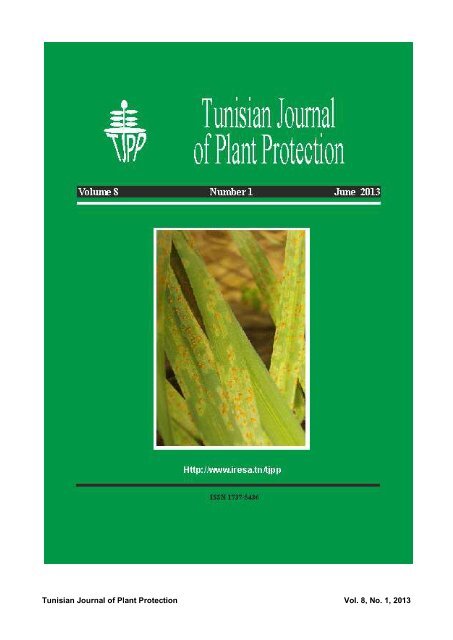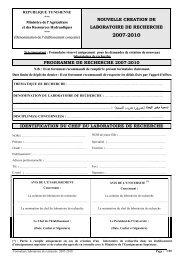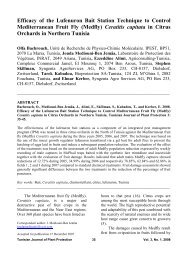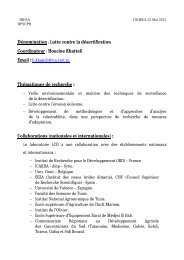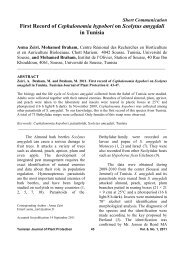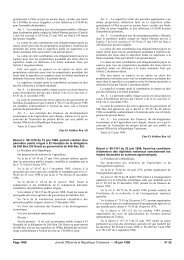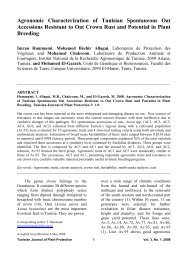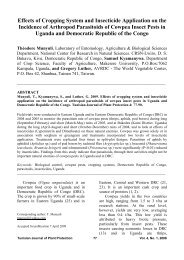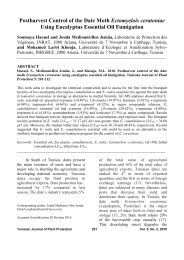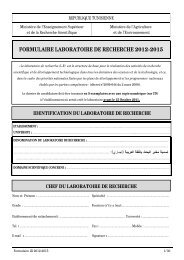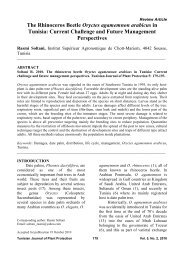Tunisian Journal of Plant Protection Vol. 8, No. 1, 2013 - Iresa
Tunisian Journal of Plant Protection Vol. 8, No. 1, 2013 - Iresa
Tunisian Journal of Plant Protection Vol. 8, No. 1, 2013 - Iresa
- No tags were found...
You also want an ePaper? Increase the reach of your titles
YUMPU automatically turns print PDFs into web optimized ePapers that Google loves.
<strong>Tunisian</strong> <strong>Journal</strong> <strong>of</strong> <strong>Plant</strong> <strong>Protection</strong> <strong>Vol</strong>. 8, <strong>No</strong>. 1, <strong>2013</strong>
<strong>Tunisian</strong> <strong>Journal</strong><strong>of</strong><strong>Plant</strong> <strong>Protection</strong><strong>Vol</strong>ume 8Number 1June <strong>2013</strong>Scientific <strong>Journal</strong> Hosted in theInstitution de la Recherche et de l’Enseignement Supérieur Agricoles( Tunisia)Created and Hosted in the Ecole Supérieure d’ Agriculture du Kef ( Tunisia ),from 2006 to 2012Editor-in-ChiefNasraoui, BouzidPhytopathology, INATAssistant Editor-in-ChiefDaami-Remadi, MejdaPhytopathology, C R R H A B ChM -Barbouche, NaïmaEntomology, I N A TBen Hamouda, M. HabibEntomology, I N A TBen Jamâa, M. LahbibEntomology, I N R G R E FChérif, MohamedPhytopathology, I N A T/ C T AHajlaoui, M. RabehPhytopathology, I N R A TEditorial BoardHamada,WalidDisease Resistance,E S A KHorrigue-Raouani, NajetNematology, I S A Ch-MKsantini, MohieddineEntomology, I OMekki, MounirWeed & Pesticide Sc., I S A Ch-MRhouma, AliPhytopathology, I OEvaluation Board<strong>Tunisian</strong> Scientists and :Abou-Haider, Mounir G., Phytopathology, CanadaBayaa, Bassam, Phytopathology, SyriaBenazoun, Abdessalam, Entomolgy, MoroccoBernier, Louis, Phytopathology, CanadaBesri, Mohamed, Phytopathology, MoroccoBouzned, Zouaoui, Phytopathology, AlgeriaDellagi, Alia, Phytopathology, FranceDu Jardin, Patrick, Biotechnology, BelgiumDuncan, Larry, Nematology, Florida USAFargette, Mireille, Nematology, FranceFuchs, Jacques G., Biol. Control, SwitzerlandHullé, Maurice, Entomology, FranceIppolito, Antonio, Phytopathology, ItalyKamoun, Sophien, Phytopathology, Ohio USAKema, Gert, Phytopathology, NetherlandsKerlan, Camille,Phytopathology, FranceKreiter, Serge, Acarology, FranceKremer, Robert J., Weed Sc., Missouri USALepoivre, Philippe,Phytopathology, BelgiumLieutier, François, Entomology, FranceMakkouk, Khaled, Phytopathology, LebanonMateille, Thierry, Nematology, FranceMugniery, Didier, Nematology, FrancePeever, Tobin, Phytopathol., Washington St., USARamade, François, Eco-Toxicology, FranceReignault, Philippe, Phytopathology, FranceRusso, Agatino, Entomology, ItalySchiffers, Bruno, Pesticide Sc., BelgiumSchoelz, James, Phytopathology, Missouri USASimpson, Stephen J., Entomology, AustraliaTirilly, Yves, Phytopathology, FranceZiedan, El Sayed, Phytopathology, EgyptSustaining MembersInstitution de la Recherche et de l’Enseignement Supérieur Agricoles (IRESA)Ecole Supérieure d’Agriculture du Kef (ESAK)Visa no. 2872/04-04-2005<strong>Tunisian</strong> <strong>Journal</strong> <strong>of</strong> <strong>Plant</strong> <strong>Protection</strong> <strong>Vol</strong>. 8, <strong>No</strong>. 1, <strong>2013</strong>
<strong>Tunisian</strong> <strong>Journal</strong> <strong>of</strong> <strong>Plant</strong> <strong>Protection</strong>http://www.iresa.tn/tjppemail: tjpp@iresa.tn<strong>Vol</strong>ume 8, Number 1, June <strong>2013</strong>ContentsMYCOLOGY1. Some recent progress in oat crown rust in Tunisia. M.B. Allagui.(Tunisia)7. Use <strong>of</strong> seminotherapy to improve the control <strong>of</strong> Septoria leaf blotch <strong>of</strong>durum wheat in Tunisia. K. Taher, M.M. Fakhfakh, A. Bouajila, S.Rezgui, M. Khammassi, J. Haber, B. Nasraoui, and A. Yahyaoui.(Tunisia/Germany)ENTOMOLOGY23. Hot air treatment for postharvest control <strong>of</strong> the date mothEctomyelois ceratoniae. A. Zouba, M. Jmoui, B. Chermiti, A. Msetra,and H. Bouabidi. (Tunisia)33. Fumigant control <strong>of</strong> the Mediterranean flour moth Ephestiakuehniella with the noble laurel Laurus nobilis essential oils. J.Mediouni-Ben Jemâa, N. Tersim, E. Boushih, K. Taleb-Toudert, and M.L.Khouja. (Tunisia/Algeria)45. Parasitoids <strong>of</strong> the almond bark beetle Scolytus amygdali in Tunisia. A.Zeiri, M. Braham, and M. Braham. (Tunisia)57. Molecular identification <strong>of</strong> Eurytoma striolata reared from almondbark beetle Scolytus amygdali in Tunisia. A. Zeiri, M. Braham, and M.Braham. (Tunisia)Photo <strong>of</strong> the cover page: Oat crow rust disease (Courtesy Mohamed Bechir Allagui)<strong>Tunisian</strong> <strong>Journal</strong> <strong>of</strong> <strong>Plant</strong> <strong>Protection</strong> <strong>Vol</strong>. 8, <strong>No</strong>. 1, <strong>2013</strong>
Guest EditorialPesticides and Beneficial Insects: Do we Need BetterRegulations?The controversy around banningpesticides that has an adverse effect onbeneficial insects such as bees or naturalenemies <strong>of</strong> pests that attack economiccrops is many decades old, but no seriousaction on this issue was taken bygovernments across the globe. Recentnews indicated that the European Unionis seriously considering to establish atwo-year ban on three pesticidessuspected <strong>of</strong> contributing to the globaldecline in the number <strong>of</strong> bees. Already 15countries voted to allow the EuropeanCommission (EU) to restrict the use <strong>of</strong>insecticides from December 2012.However, it seems that the EU failed toreach the majority needed to adopt theban outright, meaning the decision ispassed to the EU.The three insecticides are“imidocloprid”, “clothianidin” and“thiamethoxam”, all <strong>of</strong> them are used asseed treatment in addition to applyingthem as soil drench or sprayed on beeattractiveplants, such as cereals. It isimportant to note that bee numbers wentdown in the Middle East, Europe andUSA by up to 85% in some regions.The role <strong>of</strong> bees in helping plantsto bear fruits through enhancement <strong>of</strong>flower pollination is a commonknowledge. However, the influence <strong>of</strong> themanufacturing companies on the politicalmachine <strong>of</strong> their respective countries isalways a hurdle which is not easy tocross. Accordingly, eight countries,including the United Kingdom votedagainst the ban. The pesticides companiesstress the point that the ban is a poordecision because it is based on anincomplete scientific analysis. This is anopen invitation to world scientists,including those in the Middle East and<strong>No</strong>rth Africa to investigate this issuefurther and produce reliable data thatcan explain what happens in the field.Many small farmers rely on the incomegenerated by bee products, not to mentionthe indirect other benefits <strong>of</strong> a balancedbee population, and if the scientificevidence proves harmful effects <strong>of</strong> somechemicals to bees or other beneficialinsects, the ban should also be consideredoutside Europe.Dr. Khaled MakkoukNational Council for Scientific ResearchBeirut, Lebanon<strong>Tunisian</strong> <strong>Journal</strong> <strong>of</strong> <strong>Plant</strong> <strong>Protection</strong> <strong>Vol</strong>. 8, <strong>No</strong>. 1, <strong>2013</strong>
<strong>Plant</strong> <strong>Protection</strong> NewsAnnouncement<strong>of</strong>The 1 st Africa-International Allelopathy Congress(AIAC-2014)Sousse, Tunisia, February 6 – 9, 2014I. BackgroundAllelopathy Looking AheadThe rapidly growing humanpopulation has increased the dependenceon fossil fuel based agrochemicals(fertilizers or pesticides) to produce therequired agricultural and forestryproducts. This has exerted a greatpressure on the non-renewable fossil fuelresources, which cannot last indefinitely.Besides, agrochemicals pollute theenvironment, the pests develop toleranceto pesticides and their new resistantstrains are emerging. Hence, suchpractices cannot remain in use for ever.One safe alternative to overcome theseproblems is the use <strong>of</strong> allelopathy tosustain development in agriculture andforestry and maintenance <strong>of</strong> a cleanenvironment for our future generations.Allelopathy has great potential to increasethe productivity <strong>of</strong> field crops, vegetables,fruits/forestry trees, fisheries etc., usingallelochemicals as pesticides and asgrowth regulators (using the stimulatoryallelopathic effects) in agriculture.Besides, it aims at reducing theenvironmental pollution and maintainingan ecological balance in fauna and florathrough reduced use <strong>of</strong> nitrogenousfertilizers and pesticides (weedicides,nematicides, insecticides and fungicides)and substituting them with biologicalnitrogen fixation, natural products (plantand microbial), allelochemicals andphytochemicals free from all problemsarising from the use <strong>of</strong> agrochemicals.Allelopathy is a new and potential area <strong>of</strong>research. Although farmers have observedproblem's related to allelopathy since thebeginning <strong>of</strong> agriculture, planned researchwas started only from 1940. Presently,much information is available on its basicaspects in the developed countries but<strong>Tunisian</strong> <strong>Journal</strong> <strong>of</strong> <strong>Plant</strong> <strong>Protection</strong><strong>Vol</strong>. 8, <strong>No</strong>. 1, <strong>2013</strong>
very little research has been done indeveloping countries <strong>of</strong> Tropics and Sub-Tropics (suitable climate for round theyear cropping), where there is great scope<strong>of</strong> allelopathy research owing to multiplecropping, agr<strong>of</strong>orestry systems anddifferent agroecosystems. In the nearfuture, allelopathy may be used in (i).crop production, crop protection,agr<strong>of</strong>orestry and agrohorticulturalpractices, (ii) to increase agriculturalproduction in Sustainable OrganicAgriculture and (iii) to reduceenvironmental pollution. Thus, it is nowreceiving more attention from Agri- andBioscientists. Currently, OrganicAgriculture is becoming popular due tohealth concerns and public awarenessabout the ill effects <strong>of</strong> ModernAgriculture. Hence, this Congress aims (i)to bring together active allelopathyresearchers from worldwide, (ii) tohighlight the present status <strong>of</strong> research inthe thrust areas and to plan for the future,(iii) to review progress, (iv) to identifyconstraints and (v) to project future goalsfor Basic and Applied AllelopathyResearch in Organic Agriculture.Congress themes:In multiple sessions, the followingthemes will be developed:T1: Allelopathy in sustainable andorganic agricultureT2: Allelopathy in natural ecosystemsT3: Allelopathy in soil sicknessT4: Chemistry <strong>of</strong> allelochemicalsT5: Molecular biology and genetics <strong>of</strong>allelopathyT6: Physiology and biochemistry <strong>of</strong>allelopathyT7: Allelopathy mechanisms andinteractionsT8: Allelopathy methodologies andmodelingII. OrganizersThe 1st Africa-InternationalAllelopathy Congress will be organizedjointly by the Higher Agronomic Institute<strong>of</strong> Chott-Mariem (ISA-ChM) & the<strong>Tunisian</strong> Association for SustainableAgriculture in collaboration with:Allelopathy <strong>Journal</strong><strong>Tunisian</strong> <strong>Journal</strong> <strong>of</strong> <strong>Plant</strong> <strong>Protection</strong>Regional Center <strong>of</strong> Research onHorticulture and Organic AgricultureTechnical Center <strong>of</strong> OrganicAgricultureAlumni Association <strong>of</strong> ISA-ChMGraduate school <strong>of</strong> ISA-ChMResearch Unit “AGROBIODIVER-SITE”CoordinatorRabiaa Haouala (ISA-ChM, Tunisia)Organizing CommitteeKhemeis Abdellaoui (ISA-ChM, Tunisia)Hamadi Boussetta (ISA-ChM, Tunisia)Ikbal Chaieb (CRRHAB, Tunisia)Mejda Daami-Remadi (CRRHAB,Tunisia)Bouthaina Dridi-Al Mouhandes (ISA-ChM, Tunisia)Sadok Kammoun (ISA-ChM, Tunisia)Raja Kammoun (ISA-ChM, Tunisia)Raoudha Khanfir-Ben Jenana (ISA-ChM,Tunisia)Shi-ming Luo (South China AgriculturalUniversity, China)Shamsher S. Narwal (Chief EditorAllelopathy <strong>Journal</strong>, India)National Scientific CommitteeKhemeis Abdellaoui (ISA-ChM)Chedly Abdelly (CBBC)Mohamed Ben Khedher (CTAB)Mohamed Bouaziz (ISBS)Abdelhamid Boujelben (ISA-ChM)Olfa Bousaadia (IO)Hamadi Boussetta (ISA-ChM)Ikbal Chaieb (CRRHAB)Brahim Chermiti (ISA-ChM)<strong>Tunisian</strong> <strong>Journal</strong> <strong>of</strong> <strong>Plant</strong> <strong>Protection</strong> <strong>Vol</strong>. 8, <strong>No</strong>. 1, <strong>2013</strong>
Mejda Daami-Remadi (CRRHAB)Bouthaina Dridi-Al Mouhandes (ISA-ChM)Néziha Ghanem-Boughanmi (FSB)Rabiaa Haouala (ISA-ChM)Hayfa Jabnoun-Khiareddine (CRRHAB)Sadok Kammoun (ISA-ChM)Raja Kammoun (ISA-ChM)Raoudha Khanfir-Ben Jenana (ISA-ChM)Asma Laarif (CRRHAB)Messaoud Mars (ISA-ChM/CRRHAB)Mohamed Naffati (IRA-Mednine)Bouzid Nasraoui (INAT)Najet Raouani-Horrigue (ISA-ChM)International Scientific CommitteeIbrahim Alsaadawi (Bagdad University,Iraq)Min An (Charles Sturt University,Australia)Zahid Ata Cheema (University <strong>of</strong>Agriculture, Faisalabad, Pakistan)Frank Dayan (Thad Cochran ResearchCenter, USA)Marina Della Greca (Università DegliStudi, Napoli, Italy)Shi-ming Luo (South China AgriculturalUniversity, China)Shamsher S. Narwal (Chief EditorAllelopathy <strong>Journal</strong>, India)Manuel Reigosa-Roger (University <strong>of</strong>Vigo, Spain)Leslie Weston (Presidente <strong>of</strong> IAS, USA)Ren-sen Zeng (South China AgriculturalUniversity, China)III. Symposium languagesEnglish and French are the <strong>of</strong>ficiallanguages <strong>of</strong> the Congress.IV. ContactsDr. Rabiaa HaoualaThe Higher Agronomic Institute <strong>of</strong> Chott-MariemPhone: 00 (216) 73 327 544/546; GSM :00 (216) 98 526 832Fax: 00 (216) 73 327 591Dr. Mejda Daami-RemadiThe Regional Center <strong>of</strong> Research onHorticulture and Organic Agriculture <strong>of</strong>Chott-MariemPhone: 00 (216) 73 327 543; GSM : 00(216) 94 641 104Fax: 00 (216) 73 327 070Email: allelopathytunisia@yahoo.comFacebook Page: African AllelopathyV. AbstractsAbstracts submissionParticipants are invited to send anabstract in English stating the researchtheme (T1, T2,… T8). Acceptedmanuscripts will be published inAllelopathy<strong>Journal</strong>(www.allelopathyjournal.org) or in<strong>Tunisian</strong> <strong>Journal</strong> <strong>of</strong> <strong>Plant</strong> <strong>Protection</strong>(http://www.iresa.tn/tjpp). The abstractshould not exceed 300 words. Use 12 ptfont size and times new roman fonts.Official paper language: EnglishDeadlinesAbstract submission: October, 15 th <strong>2013</strong>.Acceptance notification: October, 31 th<strong>2013</strong>.Early registration: September, 15 th <strong>2013</strong>.Manuscript submission: December, 31 th<strong>2013</strong>.VI. Registration FeesLocal participants:Researchers: 350 TND (Earlyregistration), 400 TND (Lateregistration).Students: 300 TND (Early registration),350 TND (Late registration).Foreign participants:Researchers: 350 USD (Earlyregistration), 400 USD (Late registration).Students: 300 USD (Early registration),350 USD (Late registration).<strong>Tunisian</strong> <strong>Journal</strong> <strong>of</strong> <strong>Plant</strong> <strong>Protection</strong> <strong>Vol</strong>. 8, <strong>No</strong>. 1, <strong>2013</strong>
Registrationincludes:Accommodation (4 nights), breakfast,lunches, dinners, refreshment breaks,registration kit.Post Congress Tour to Famous TouristSites in Monastir, Mahdia and El Jem, forone day (optional with limited places).$50 USD (70 TND) (Travel + Food + Siteseeing Tickets, etc.).INTERNATIONAL SHORT COURSEON ALLELOPATHY (ISCA):Registration Fees (Foreigners):Scientists: 300 USD, Students: 250 USDRegistration Fees (<strong>Tunisian</strong>): Scientists:300 TND, Students: 250 TNDRegistration Deadline: December 31 th ,<strong>2013</strong>.-------------<strong>Tunisian</strong> <strong>Journal</strong> <strong>of</strong> <strong>Plant</strong> <strong>Protection</strong> <strong>Vol</strong>. 8, <strong>No</strong>. 1, <strong>2013</strong>
ReportonInternational Symposium on Crop <strong>Protection</strong> Management inMediterranean Organic AgricultureSousse, Tunisia, May 14 - 16, <strong>2013</strong>Organic Agriculture hasexperienced a rapid expansion in recentyears, with continued growth globally andin the Mediterranean region, where it<strong>of</strong>fers sustainable developmentopportunities and initiatives. Cropprotection is <strong>of</strong> major concern for thesuccessful management <strong>of</strong> organic farmsand is considered as one <strong>of</strong> the mostchallenging tasks that organic farmers arefacing. Both yield and quality can beseverely affected by pests and diseases,even if available preventive measureshave been accurately applied. Thedevelopment <strong>of</strong> ecologically soundcontrol methods against pest and diseasesis therefore a necessary part <strong>of</strong> organicresearch agendas.Some 100 researchers from 14countries (Albania, Algeria, Belgium,Egypt, Germany, Iraq, Italy, Jordan,Morocco, Poland, Saudi Arabia, Syria,and Tunisia) participated in theSymposium ‘Crop protectionmanagement in Mediterranean OrganicAgriculture’, which was jointly organizedby the Technical Center <strong>of</strong> OrganicAgriculture, Tunisia (CTAB), theInternational Society <strong>of</strong> OrganicAgriculture Research (ISOFAR) and theMediterranean Organic AgriculturalNetwork (MOAN).The organizers succeeded incompiling an attractive scientificprogram, which included about 30 oralpresentations and over 40 posters alltargeted on finding sustainable solutionsfor crop protection problems in organicplant production.The event started with aremarkable speech given by the Chief <strong>of</strong>Cabinet <strong>of</strong> the Minister <strong>of</strong> Agriculture <strong>of</strong>Tunisia. In his speech, the Chief <strong>of</strong> theCabinet confirmed that organicagriculture fits well in the nationalstrategy, which is based on selfsufficiencyin basic foodstuff, exportpromotion, protection <strong>of</strong> the environmentand improvement <strong>of</strong> farmer’s income. Inthis context, organic agriculture plays animportant role by <strong>of</strong>fering products <strong>of</strong>high quality while simultaneouslypreserving the ecological balance.Furthermore, the Chief <strong>of</strong> Cabinetmentioned that the <strong>Tunisian</strong> Governmentactively supports the development <strong>of</strong>organic agriculture, by theimplementation <strong>of</strong> a national committee,a general direction and regional directionsfor organic agriculture, a technical center<strong>of</strong> organic agriculture, etc.... Training <strong>of</strong><strong>Tunisian</strong> <strong>Journal</strong> <strong>of</strong> <strong>Plant</strong> <strong>Protection</strong> <strong>Vol</strong>. 8, <strong>No</strong>. 1, <strong>2013</strong>
farmers and innovative research isconsidered as a key element thatcontributes to the successful development<strong>of</strong> the organic sector.The plenary sessions continuedwith presentations on the current situation<strong>of</strong> organic agriculture in Tunisia, anoverview <strong>of</strong> the research activities <strong>of</strong> theMediterranean Agricultural Institute <strong>of</strong>Bari (IAMB) and an outline on currentresearch on microbial control <strong>of</strong> insects inTunisia.Further, sessions included insectand disease management with a strongfocus on microbial control and botanicals.Fortunately the list <strong>of</strong> speakers includedmany young researchers, which weregiven the opportunity to present theirresults on a conference. Fortunately, aconsiderable proportion <strong>of</strong> the youngspeakers presented high quality work.Two <strong>of</strong> them were rewarded at the end <strong>of</strong>the conference for the best oralpresentation and the best posterpresented.Another positive aspect related tothe contents was the considerable amount<strong>of</strong> contributions on basic research onpests and diseases. This type <strong>of</strong> research,e.g. on the auxiliary fauna is generallywork intensive and not easy to publish.On the other hand, this type <strong>of</strong> study is animportant part <strong>of</strong> any research agenda inorganic agriculture, which is mainlyfocusing on understanding the systemsand on the principle <strong>of</strong> prevention.Some <strong>of</strong> the approaches presentedhowever may cause problems with theself conception <strong>of</strong> organic agriculture oreven with the general legislation. The use<strong>of</strong> mycotoxin producing fungi such asAspergillus flavus, for example, is anambivalent approach for organic systems.Summaries <strong>of</strong> all contributionshave been compiled in an abstract bookthat is available via the website <strong>of</strong>ISOFAR. The last day <strong>of</strong> the Symposiumwas dedicated to an excursion which wasfocusing on citriculture and horticulturecompleted by interesting cultural visits.This symposium <strong>of</strong>fered a greatopportunity for all participants to shareinformation and experiences about cropprotection and Organic Agriculture underMediterranean conditions.The atmosphere during thesymposium was more than convenient.Foreign participants had the great chanceto enjoy the hospitality <strong>of</strong> the <strong>Tunisian</strong>hosts. The Organizing and ScientificCommittees deserve full gratitude.Dr. Mohamed Ben KhédherFor the Organizing and Scientific Committees-------------------<strong>Tunisian</strong> <strong>Journal</strong> <strong>of</strong> <strong>Plant</strong> <strong>Protection</strong> <strong>Vol</strong>. 8, <strong>No</strong>. 1, <strong>2013</strong>
Recent Doctorate Theses in <strong>Plant</strong> <strong>Protection</strong>(2012/13)Mansour, Ramzi. 2012. Toward enhancing Integrated Pest Managementprograms <strong>of</strong> mealybugs (Hemiptera: Pseudococcidae) in <strong>Tunisian</strong> and Sicilianvineyards. Doctorate Thesis in <strong>Plant</strong> <strong>Protection</strong>, joint supervision INAT,University <strong>of</strong> Carthage, Tunisia and Universita degli Studi di Catania, Italy, 156pp. (Public Defense: 22 September 2012)Two mealybug species,Planococcus ficus and Planococcus citri,and an armored scale species, Hemiberlesialataniae, were recordedthroughout <strong>Tunisian</strong> table-grapevineyards. P. ficus was by far the mostwidespread scale insect species within theinvestigated grape growing areas and wasalso recorded on fig trees. Most (74%) <strong>of</strong>the investigated <strong>Tunisian</strong> vineyards wereinfested by mealybugs. About 70% <strong>of</strong> themealybug-infested vineyards werecategorized as slightly to moderatelyinfested by these insects. All collectedAnagyrus pseudococci s.l. specimenswere identified as A. sp. nearpseudococci. Additionally, one primaryparasitoid Coccophagus sp. and onehyperparasitoid Chartocerus sp. were alsoreared from mealybugs. Six ant specieswere found in <strong>Tunisian</strong> mealybuginfestedtable-grape vineyards. They areTetramorium semilaeve, Plagiolepisschmitzii, Tapinoma nigerrimum,Crematogaster schmidti, Pheidolepallidula and Pheidole teneriffana. Thefour latter species were reported tendingmealybugs on grapevines. T. nigerrimumwas found to be the most common antspecies on grapevine and the mostassociated with the mealybugs.The morphological examination <strong>of</strong>some vine mealybug (P. ficus)populations collected from <strong>Tunisian</strong>vineyards showed the existence <strong>of</strong> twodifferent P. ficus populations in Tunisia.Likewise, in the molecular (RibosomalITS1) analysis, two separate clades wererevealed in the Neighbour-joiningphylogenetic tree, supporting themorphological studies suggesting thatthere are two distinct populations <strong>of</strong> P.ficus on grapevine in Tunisia. This is thefirst study showing the occurrence <strong>of</strong> twomorphologically and genetically differentpopulations <strong>of</strong> P. ficus on grapevine inTunisia.The number <strong>of</strong> captured A. sp.near pseudococci females in vinemealybug sex pheromone (LS) baitedtraps was significantly higher than that inunbaited traps. The minimal number <strong>of</strong>days for the first parasitoid emergence inLS baited traps was 16 days, namelyalmost 3 days earlier, compared tounbaited control. These findings resultedin a significant increase in the parasitism<strong>of</strong> the mealybugs P. citri by A. sp. nearpseudococci in LS baited traps relative tounbaited traps. Insecticide treatments(bupr<strong>of</strong>ezin or chlorpyriphos-methyl)significantly affected parasitizationactivity <strong>of</strong> A. sp. near pseudococci onmealybugs when compared to theuntreated control.<strong>Tunisian</strong> <strong>Journal</strong> <strong>of</strong> <strong>Plant</strong> <strong>Protection</strong> <strong>Vol</strong>. 8, <strong>No</strong>. 1, <strong>2013</strong>
Regarding contact toxicity, theinsecticide chlorpyriphos-methyl caused100% parasitoid mortality 24 h aftertreatment, but parasitoid mortality fromthe insecticides Prev-Am® orspirotetramat was almost absent. Neitherthe total parasitoid <strong>of</strong>fspring/female northe sex ratio <strong>of</strong> the progeny wasnegatively affected by Prev-Am® orspirotetramat relative to the untreatedcontrol. According to the IOBCclassification for laboratory trials, bothPrev-Am® and spirotetramat were ratedharmless (IOBC category 1), whereaschlorpyriphos-methyl was categorized asharmful (IOBC category 4) to A. sp. nearpseudococci. <strong>No</strong>ne <strong>of</strong> the insecticidesadversely affected the development <strong>of</strong> theparasitoid pupal stage inside vinemealybug mummies or the survival <strong>of</strong> theemerged parasitoids.In laboratory conditions,parasitism <strong>of</strong> P. ficus and P. citri by theirrespective encyrtid parasitoids A. sp. nearpseudococci and Leptomastix dactylopiiwas negatively affected by the ant T.nigerrimum. Similarly, T. nigerrimumwas shown to significantly disrupt thepredatory activity <strong>of</strong> Cryptolaemusmontrouzieri larvae when foraging onhost citrus mealybugs. By contrast, thepresence <strong>of</strong> T. nigerrimum did notnegatively influence the predatorypotential <strong>of</strong> C. montrouzieri adults whenfeeding on citrus mealybugs.Consequently, the encyrtid parasitoids A.sp. near pseudococci and L. dactylopiiand the larval stage <strong>of</strong> the predator C.montrouzieri may be considered as T.nigerrimum-sensitive, whereas adults <strong>of</strong>C. montrouzieri may be regarded as T.nigerrimum-resistant predators.-----------------Sahraoui, Hajer. 2012. Influence <strong>of</strong> agro-ecological practices and plantprotection on phytoseiid mites communities in <strong>Tunisian</strong> citrus orchards.Doctorate Thesis in <strong>Plant</strong> <strong>Protection</strong>, joint supervision INAT, University <strong>of</strong>Carthage, Tunisia and Montpellier SupAgro, France, 196 pp. (Public Defense:11 December 2012)Mites <strong>of</strong> the family Phytoseiidae(Mesostigmata) have been extensivelystudied because <strong>of</strong> the potential <strong>of</strong> severalspecies as biological control agents <strong>of</strong>phytophagous mites and small insect croppests. Phytoseiidae diversity andabundance are known to be mainlyaffected by climate, stability <strong>of</strong> habitats,food resources and agricultural practices.This study conducted in <strong>Tunisian</strong> citrusorchards aimed to (i) characterize thediversity <strong>of</strong> Phytoseiidae in theseagrosystems, (ii) study the effect <strong>of</strong>agricultural practices on the diversity andabundance <strong>of</strong> these species and (ii) studythe effect <strong>of</strong> weed management strategieson these predatory mites. The resultsobtained allow giving some responses.First, more data are now available onspecies <strong>of</strong> Phytoseiidae present on citrustrees and associated weeds. Eleven newspecies for the <strong>Tunisian</strong> fauna have beenfound species <strong>of</strong> Phytoseiidae, weredifferent according to the species <strong>of</strong> citrusconsidered and their abundance seemed tobe affected by herbicide sprayings. Onweeds, Phytoseiidae diversity wasdirectly affected by weed diversity.Furthermore, their density was influencedby pesticide sprayings and the weed<strong>Tunisian</strong> <strong>Journal</strong> <strong>of</strong> <strong>Plant</strong> <strong>Protection</strong> <strong>Vol</strong>. 8, <strong>No</strong>. 1, <strong>2013</strong>
management type. A positive correlationbetween Phytoseiidae densities on treesand weeds was emphasized. Ambulatorydispersal between weeds and trees wasobserved and migrations were higherfrom weeds to trees than in the oppositeway. This dispersal seemed to be favoredby some weeding practices, especially byploughing. At last, the comparison <strong>of</strong>plots conducted with different farmingstrategies showed that Phytoseiidaediversity was the highest in the organicfarming plot. The results presentlyobtained allow a better understanding <strong>of</strong>relationships between Phytoseiidae andtheir habitat. They also allow someproposals to improve agriculturalpractices and promote a better biologicalcontrol <strong>of</strong> mite pests (eliminate herbicideuse, promote ploughing and mowing).However, additional studies are stillrequired in order to test more weedingstrategies, propose new ones and to bettercharacterize the interactions betweenPhytoseiidae and agrosystemsmanagement.---------------<strong>Tunisian</strong> <strong>Journal</strong> <strong>of</strong> <strong>Plant</strong> <strong>Protection</strong> <strong>Vol</strong>. 8, <strong>No</strong>. 1, <strong>2013</strong>
Instructions to AuthorsThe <strong>Tunisian</strong> <strong>Journal</strong> <strong>of</strong> <strong>Plant</strong> <strong>Protection</strong> is published in English twice a year.Contributions on all aspects <strong>of</strong> plant protection are considered. Papers are evaluated by highlyqualified national and international scientists <strong>of</strong> the related disciplines.The original manuscript should be submittedto the Editor-in-Chief :Pr<strong>of</strong>. Bouzid NasraouiInstitut National Agronomique de Tunisie,43 Avenue Charles Nicolle, 1082 Tunis-Mahrajène, TunisiaEmail: tjpp@iresa.tnPhone: (+216)982929 17Submitted manuscript must not be published or submitted for publication elsewhere.Manuscripts should be emailed on Micros<strong>of</strong>t Word and Micros<strong>of</strong>t Excel. It should be typed on oneside page (A4 format) in double space (Times New Roman, 12), starting by the title in the center,followed by author names and their addresses. Three abstracts are required : English, Arabic andFrench. The two latter come at the end <strong>of</strong> the manuscript. When necessary, the <strong>Journal</strong>may translatethe English abstract into Arabic and/or French.Abstracts start with the title <strong>of</strong> the manuscript and finish by the keywords with sevenwords at most. The other sections <strong>of</strong> the manuscript are : Introduction, Materials and Methods,Results, Discussion, Acknowledgement (if necessary), French and Arabic abstracts, and LiteratureCited. <strong>No</strong>t divided short communications and review articles are also published.Tables should be cited in numeric order in the manuscript. They must be intelligiblewithout reference to the text. The title should summarize the information presented in the table.Subheadings should be brief. Abbreviations are accepted but those which are not standard must beexplained in footnotes.Figures should also be presented in numeric order. Captions should describe the contents,so each illustration is understandable when considered apart from the text. Color photos arepublished only on-line; they are black and white on the paper version.References in the text should be cited by their numbers. In the Literature Cited, referencesmust be reported in their original language when latin alphabet is used, otherwise, they have to betranslated to English between square brackets and their original language mentioned betweenbrackets. They should be numbered and arranged in alphabetical order, with author last names, theirinitials, publication year, title, journal or other source, volume and page numbers. Examples belowmust be followed.Article in a journal :Haddar, T. 1989. Check list <strong>of</strong> weeds naturally infesting agricultural fields in northern Tunisia. Arab<strong>Journal</strong> <strong>of</strong> <strong>Plant</strong> <strong>Protection</strong> 7: 174-178.Chapter in a book :Nasraoui, B. and Lepoivre, P. 2003. Les champignons phytopathogènes. Pages 111-143. In:Phytopathologie, bases moléculaires et biologiques des pathosystèmes et fondements desstratégies de lutte. P. Lepoivre, Ed. Editions De Boeck Université. Belgium.Proceedings :Medini, M., Hamza, S., Harrabi, M., and Lamari, L. 2003. Virulence <strong>of</strong> Mycosphaerellagraminicolafrom Tunisia, Algeria and Canada. Pages 14-44. In: Proceedings <strong>of</strong> the 6 thInternational Symposium on Septoria and StagonosporaDiseases <strong>of</strong> Cereals. December 8-12, 2003, Tunis, Tunisia.Book :Jarraya, A. 2003. Principaux nuisibles des plantes cultivées et des denrées stockées en Afrique du<strong>No</strong>rd: leur biologie, leurs ennemis naturels, leurs dégâts et leur contrôle. Maghreb Editions,Tunisia, 415 pp.Thesis :Horrigue-Raouani, N. 2003. Variabilité de la relation hôtes-parasites dans le cas des Meloidogynespp. (Tylenchida, Meloidogynidae). Doctorat Es-Sciences Naturelles. Faculté des Sciencesde Tunis, Université Al-Manar, Tunisia, 222 pp.<strong>Tunisian</strong> <strong>Journal</strong> <strong>of</strong> <strong>Plant</strong> <strong>Protection</strong> <strong>Vol</strong>. 8, <strong>No</strong>. 1, <strong>2013</strong>
<strong>Tunisian</strong> <strong>Journal</strong> <strong>of</strong> <strong>Plant</strong> <strong>Protection</strong> <strong>Vol</strong>. 8, <strong>No</strong>. 1, <strong>2013</strong>


